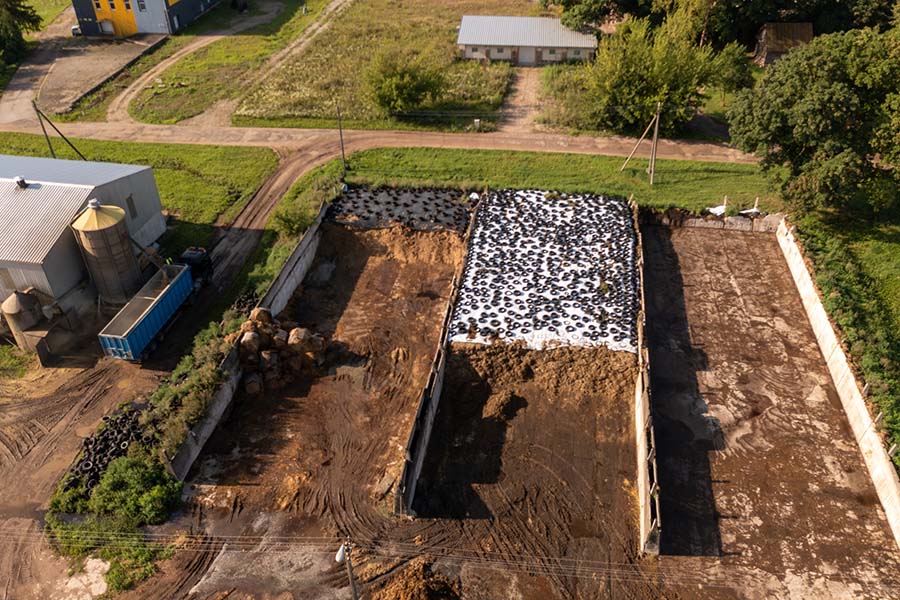Your Silage's Best Friend: Why Silage Covers Matter
You've put a lot of time, effort, and money into producing top-notch silage. But your job isn't done once the harvest is in. You need a high-quality silage cover to protect your investment and make sure your livestock get the most out of your feed.
Think of a silage cover as your feed's best friend. It's more than a simple tarp – a high-quality cover keeps oxygen, moisture, and temperature fluctuations at bay, preventing nutrient loss and the growth of harmful molds and bacteria.
This guide will break down everything you need to know about silage covers, including what types are available, their primary features, and tips on choosing the right cover for your farm.
Finding the Right Silage Cover
Since the characteristics of a silage cover directly affect the quality of stored feed, including how long it lasts, it's important to understand the pros and cons of different covers.
Traditional Tarps: The Old Standby
Traditional tarps have been around for decades and are still popular with many farmers. They're typically made from a single layer of woven or non-woven material.
Polyethylene Film (PE)
These tarps are a budget-friendly option that offers basic protection from rain and sun. However, they can be prone to tears and punctures, and their UV resistance varies.
Canvas
Canvas tarps are known for their strength and durability, but they're heavier and more expensive than PE tarps.
Woven Fabrics
Basic woven tarps are generally affordable with improved durability over sheet plastics. They're usually available as woven polypropylene (PP), polyethylene (PE), and polyester.
Advanced Geomembranes
Advanced geomembranes are a step up from traditional tarps. These high-tech covers feature multiple layers, reinforced for added durability and ease-of-use.
Toughness
Thanks to their multilayer construction, advanced geomembranes are incredibly resistant to punctures, tears, and abrasion, so they last longer and need fewer repairs, saving you money in the long run.
Weatherproof
These covers can handle just about anything Mother Nature throws their way, from scorching sun and heavy rain to freezing temperatures and strong winds.
UV Protection
Many geomembranes have built-in UV protection to prevent them from breaking down in the sunlight.
Flexibility
Despite their strength, many advanced geomembranes are surprisingly lightweight and flexible, making them easy to handle and ensuring a tight seal around your silage pile.
Customizable
Geomembranes can be custom-fitted to your silo for optimal coverage.
Types of Geomembranes
BTL Liner's ArmorCover geomembranes are available in 9, 12, and 16 mil thicknesses and feature a tough woven core sandwiched between layers of LDPE and HDPE for exceptional strength and durability. Their black/white design helps regulate temperature within the silage pile, while custom cutting and factory seaming ensure a perfect fit for any silo.
BTL offers another geomembrane option featuring a reinforcing string layer sandwiched between LDPE layers for enhanced durability without the bulk of a woven scrim. They also feature a black/white design and custom-cut options.
Oxygen Barrier Films
Oxygen barrier films are like a superhero sidekick for your silage cover. They're used in conjunction with traditional tarps or geomembranes to create an extra barrier against oxygen, helping to prevent spoilage and maintain the quality of your silage.
These films are made from special polymers that are incredibly effective at keeping oxygen out. This characteristic helps preserve the silage and keep it from breaking down as quickly when you open it up to feed your livestock.
Oxygen barrier films are typically used with a traditional tarp or geomembrane cover. The film is applied directly to the silage before the primary cover is put in place for a double layer of protection.
Finding the Perfect Fit: What to Consider When Choosing a Silage Cover
Choosing the right silage cover is a bit like finding the perfect pair of boots – it needs to fit your needs and the working conditions you'll be facing. Here are some key factors to keep in mind:
Choosing a Cover for Your Climate
Sun Protection
If you live in a sunny area, choose a cover with strong UV protection to prevent it from breaking down in the sun.
Rain Resistance
In rainy regions, pick a cover that can handle a downpour and consider using an oxygen barrier film for extra protection against moisture.
Wind Resistance
For windy locations, choose a heavy-duty, reinforced cover that can withstand strong gusts. Make sure it's properly secured and weighted down.
Temperature Tolerance
Consider the temperature swings in your area and choose a cover that can handle both hot and cold weather without becoming brittle or falling apart.
Budget vs. Longevity: Finding the Right Balance
Silage covers come in a range of prices, from basic tarps to high-tech geomembranes. Think about how long you want the cover to last. More durable covers, like geomembranes, may cost more upfront but will last longer and need replacing less often, which saves money over time. Find a cover that offers the best value for your needs and budget.
Material Matters: Key Properties to Look For
Puncture Resistance
Choose a cover that can withstand punctures from sharp objects like rocks, sticks, or animal hooves.
Tear Resistance
Make sure the cover is resistant to rips and tears that can let air and moisture in, leading to spoilage.
UV Resistance
Look for a cover with good UV protection to prevent it from degrading in the sunlight.
Water Resistance
The cover should be excellent at keeping rainwater out to prevent spoilage.
Flexibility
The cover should be flexible enough to conform closely to the shape of your silage pile, minimizing air pockets.
Bonus Features: The Icing on the Cake
Heat Reflection
A cover with a white outer layer can help reflect sunlight and keep your silage cooler.
Oxygen Barrier
For added protection against spoilage, consider using an oxygen barrier film with your cover.
Custom Fit
If you have an unusual silo shape or specific size requirements, consider a custom-made cover.
Reaping the Rewards: Why Silage Covers Matter
Protecting your silage is an investment that pays off in many ways. A well-covered silage pile means healthier, more productive livestock and a thriving farm. So, take the time to choose the right silage cover – your livestock (and your bottom line) will thank you!




